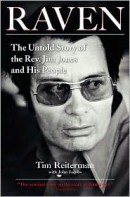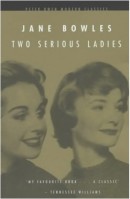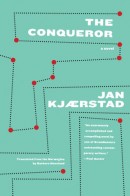 Recommended by Jennings in Chicago.
Recommended by Jennings in Chicago.
Written on the eve of the First World War, this novel allows itself strange indulgences. In place of a narrative arc, we have a walking tour, an eccentric professor as our guide, which collapses into a great number of impossibly intricate (yet not unintelligible) stories-within-stories. This penetrating, multiplying tool which Roussel uses to see how narratives contain other narratives ad infinitum has a corollary in his descriptions of the outrageous involuted mechanical sculptures-cum-scientific artworks that adorn the grounds of his mansion Locus Solus. We never get there of course, but the narrative paths along which we try to move are so engrossing that we hardly feel the unrealized destination as a loss.
The Shelf is a running list of recent (and occasionally not-so-recent) releases, with a mix of Second Pass opinion and excerpts from other reviews.
Monday, March 30th, 2009
Locus Solus by Raymond Roussel
Tuesday, March 24th, 2009
The Moon is a Harsh Mistress by Robert Heinlein
 Recommended by Manuel in San Antonio, Texas.
Recommended by Manuel in San Antonio, Texas.
I have always been guilty of the prejudice that many of us harbor against science fiction. This novel, however, is anything but a run of the mill sci-fi book. It’s an in-depth analysis of the merits and deficiencies of anarchism, unregulated free markets, monogamous/polygamous relationships, and political conflict resolution. The story is set against the backdrop of a lunar colony population that decides to revolt and secede from Earth. In so doing, moon inhabitants must wrestle with creation of government, the redefinition of politics, and “national” defense. Interesting parallels to the birth of the United States are made throughout and cause the reader to stop and think about how our culture and government(s) have evolved.
Friday, March 20th, 2009
44 Scotland Street by Alexander McCall Smith
 Recommended by Jake in Dallas, Texas.
Recommended by Jake in Dallas, Texas.
I have recently stumbled across Alexander McCall Smith, a British author who has written several series of books. One of those series (four or five novels) starts with 44 Scotland Street, a chronicle of several well drawn characters who are making life’s journey in Edinburgh. They range from young to old, ambitious to lazy, self-conscious to narcissistic, and pretentious to genuine. The author makes each one interesting through the small acts of everyday living as he touches lightly on universal themes. This novel may not be a thrill-a-minute ride, but I was eager to pick up where I left off the day before and rejoin my new acquaintances.
Wednesday, March 18th, 2009
Raven by Tim Reiterman
 Recommended by Ray in San Antonio, Texas.
Recommended by Ray in San Antonio, Texas.
The study of Reverend Jim Jones and his Peoples Temple has become a cottage industry. I’ve read the majority of the books written on the subject, but none are as captivating and thorough as Tim Reiterman’s definitive Raven. Reiterman is uniquely qualified to tell the story of Jonestown. He was one of the handful of California journalists who first tried to pull the veil away to reveal the real and complex workings of Peoples Temple in the mid and late ’70s. Reiterman was in Jonestown the night before the end. His firsthand description of that night is visceral and gripping. The next morning he lay shot on a desolate airstrip at Port Kaituma and left for dead (along with other journalists and congressman Leo Ryan, who is the only congressman in the history of the United States to be murdered while in office) by Jonestown paramilitary assassins. The original book was written only a couple of years after the events of Jonestown, but Reiterman has updated it in a new printing.
Tuesday, March 17th, 2009
The Girl With the Dragon Tattoo by Stieg Larsson
 Recommended by Marija in Zagreb, Croatia.
Recommended by Marija in Zagreb, Croatia.
I would like to recommend the entire Millennium series* by Stieg Larsson, but let’s start with the first part of the trilogy — The Girl With The Dragon Tattoo. The shortest way to describe it is “thriller,” but it’s more than that. It’s a deftly woven mix of a family history, a murder mystery, and a story of modern journalism. It’s also a personal history of the girl with the tattoo. To the eyes of the world seems like a damaged creature, but in fact she’s one of the most interesting female investigators ever thought up. Several friends recommended it to me, so I wanted to check what all the fuss was about. I ended up not being able to put it down. The characters are compelling and rounded, and although extraordinary in their different ways, they are, in the end, believable. I would like to give this book to Dan Brown so he can see how a great thriller is done.
*Ed. Note: This is the first book in the mentioned Millennium series, and the only one published in the U.S. so far. The second book will be published here in July.
Monday, March 16th, 2009
Jessica Z. by Shawn Klomparens
 Recommended by Kathleen in Bozeman, Montana.
Recommended by Kathleen in Bozeman, Montana.
Jessica Z. takes place in an unsettling and entirely believable version of the United States where terrorism is not only commonplace, it’s virtually accepted as normal. The titular Jessica is a sardonic, self-conscious twenty-something copywriter living in San Francisco, ambivalent about her job and unsteady in relationships, particularly the one she’s been stumbling through with her upstairs neighbor, Patrick. When Jess finds herself involved with a manipulative artist as the subject of his latest project, her eyes are painfully opened to the fact that nothing in her world is at all what it seemed. Little details bring Jessica Z. alive, and the spot-on first person narration pushes the reader into a not-too-easy resolution with an urgency that never feels rushed. It’s a book that refuses to be categorized, and sticks with you long after you’ve put it down.
Monday, March 16th, 2009
Two Serious Ladies by Jane Bowles
 Recommended by Dan in Queens, NY.
Recommended by Dan in Queens, NY.
Two Serious Ladies has been on my list of books to read for ages; after reading it last week, I find myself astonished that I could have lived for so long without it. Bowles’ two ladies and their generally unlikeable acquaintances live in an America that’s as much Kafka’s as anyone else’s; and like his characters, they are passively (and hilariously) swept along by fate. What’s most touching about the book is the obvious amount of respect that Bowles has for her characters: in other hands, they would become monsters, but in her world they calmly march along, impervious to their idiosyncrasies. It’s a short novel, but just about perfect, and I can’t help but wonder why she seems to be popularly known as a footnote to her husband Paul.
Tuesday, March 10th, 2009
The Conqueror by Jan Kjaerstad
Recommended by E.J. in Rochester, New York.
The Conqueror is the second novel in a trilogy of books about the fictional Norwegian television celebrity Jonas Wergeland. While the experience of reading all three novels is not to be missed, each book is also written in such a way that it can stand alone. Kjaerstad is one of Norway’s most popular and well-regarded novelists, and he told me that he wrote this trilogy to tell the story of his tribe, the Norwegians. He tells this epic story like a pointillist painter. The Conqueror is made up of a series of small chapters, each of which tells a more or less self-contained story, a moment in Wergeland’s life. I sometimes get carried away by the architecture of the thing, but as impressive as that architecture is, what makes The Conqueror great, and what makes the Wergeland trilogy so incredible as a whole, is how natural Kjaerstad makes the whole project feel; however ornate the substructure, there’s ease in how he tells one compelling story after another. Seemingly effortless and highly imaginative, the stories we’re told about Jonas’s fascinating, complicated life are what make these novels so amazing.
Tuesday, March 10th, 2009
We by Yevgeny Zamyatin
Recommended by Ranylt in Ottawa, Canada.
Early twentieth-century writers did dystopian fiction best. Zamyatin’s 1921 novel is pure sci-fi with an anti-conformity message (the kind popularized in Logan’s Run and THX 1138). A thousand years in the future, Soviet power has collected earth’s population into One State. Humans are called “numbers” instead of “people,” worship the hive mind, and live in transparent houses in a glass city. When a mathematician falls in love, he begins to evolve from a component to a unit, and discovers that the State’s utilitarian formulas for happiness (via “unfreedom”) are flawed. The Modernist prose is breathtakingly curt, and the subversion is in-your-face; Zamyatin couldn’t get his novel published for decades and was expelled from the USSR.
Tuesday, March 10th, 2009
Black Hole by Charles Burns
 Recommended by Dan in Los Angeles.
Recommended by Dan in Los Angeles.
Black Hole is a stunning book, a graphic novel that reminds you just how much power can be packed into the medium. Originally published in 12 volumes over 10 years, this collected work is a masterpiece of teenage angst and heartbreak mixed with the biting politics of the social outcast. Set in suburban Seattle in the 1970s, the story follows high schoolers infected with an STD known only as “the bug” that manifests itself in mutations including tails and extra mouths. Burns is wise enough to keep the disease’s origins a mystery, and though the story flirts with melodrama (murders and runaways), it never rings false. It’s an engrossing and moving read.
Tuesday, March 10th, 2009
The Turnaround by George Pelecanos
 Recommended by Dustin in Portland, Maine.
Recommended by Dustin in Portland, Maine.
If you’re suffering from withdrawal from “The Wire,” you’d be wise to read the novels of some of the show’s writers. After reading Dennis Lehane’s phenomenal The Given Day, I turned to Pelecanos, who wrote extensively for the show. Although not as gritty as “The Wire” (nor a mystery), The Turnaround has similar characterization – in fact, I couldn’t help but picture several of the characters from the show (Cutty, in particular) playing characters in this book. Set initially in the early 1970s, it’s about a trio of misguided white teenagers who drive into the black part of D.C. to harass the residents. One kid is killed, and another badly injured. The action then picks up in the present day, as the participants of that night – both the surviving victims and the assailants – are still struggling with the aftermath. It’s an extraordinary, gripping urban crime novel; a rich, realistic character study; and far more literary than you’d expect from a genre novel. More importantly, it also goes a long way toward killing those withdrawal pangs.



